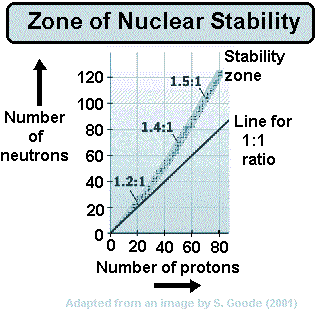Neutron Emission Neutron emission is nuclear radiation that is made up of emitted neutrons
If a nucleus has too many neutrons to be stable it will either emit beta particles (to decrease the number of neutrons and increase the number of protons) or simply emit a neutron - whichever makes it more stable. A neutron has a mass of 1.0 u (see atomic mass unit), a nucleon number (atomic mass) of 1 and a proton number (atomic number) of 0. Neutron emission therefore causes the mass number of the nucleus to decrease by one and the atomic number remains the same - meaning that the nucleus is still of the same element after neutron emission. Symbol: Only rarely it is possible for a neutron to be emitted by radioactive decay. This can occur naturally, if a nucleus becomes unstable by absorbing cosmic rays. This often occurs high up in the atmosphere, but is very rare on the Earth's surface. More often it occurs artificially - it is insigated by human action. For example James Chadwick fired alpha particles at Beryllium and this resulted in neutrons being emitted in that experiment. A further example of neutron emission is during nuclear fission reactions, where neutrons are released from the parent nucleus as it splits. Penetrating PowerNeutrons are very penetrating - much more than alpha or beta radiation - even more so than gamma radiation. UsesCold, thermal and hot neutron radiation is most commonly used in scattering and diffraction experiments, to assess the properties and the structure of materials in crystallography, condensed matter physics, biology, solid state chemistry, materials science, geology, mineralogy, and related sciences. Neutron radiation is also used in Boron Neutron Capture Therapy to treat cancerous tumors due to its highly penetrating and damaging nature to cellular structure. Neutrons can also be used for imaging of industrial parts termed neutron radiography when using film, neutron radioscopy when taking a digital image, such as through image plates, and neutron tomography for three-dimensional images. Neutron imaging is commonly used in the nuclear industry, the space and aerospace industry, as well as the high reliability explosives industry.
|
Follow me...
|







